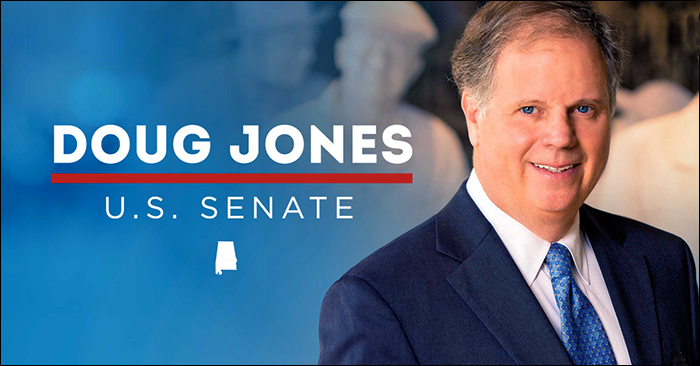By Jim Ellis
Dec. 14, 2017 — With the final polling covering all possibilities — from Democrat Doug Jones leading by 10 points, to Republican Roy Moore ahead by nine, to a straight tie — Tuesday’s Alabama special Senate election carried a great deal of uncertainty as voters cast their ballots.
Republicans were badly split between those party leaders publicly repulsed by the allegations of sexual impropriety against Moore, to those who felt that holding the seat and preventing the Democrats from having any path to obtaining the Senate majority in 2018 was most important.
The split was enough to allow Democrat Jones, a former Birmingham region US Attorney, to slip past Judge Moore and secure what previously had been a safely Republican seat for the next three years. Jones will replace appointed Sen. Luther Strange (R) who fell to Moore in the Republican run-off in late September.
The unofficial final totals give Jones 49.9 percent of the vote as compared to Moore’s 48.4 percent. Election Day’s final turnout figure showed 1,344,406 individuals having cast ballot, a total that will increase when all absentee and provisional ballots are finally added to the mix. In comparison, the last gubernatorial election (2014) drew 1,180,413. The 2016 presidential campaign saw 2,123,372 votes cast. Therefore, this special election, as did others earlier in the cycle (MT-AL; GA-6), actually produced a higher voter turnout than the state’s last regular midterm election.
Clearly, Judge Moore could not command the required margin Republican vote in a large turnout election. Predictably, he fell short of his vote goals in places like Shelby County, a rock-solid Republican county that serves as a bedroom community to Birmingham. While he won Shelby 56-42 percent, Republican candidates normally rack up win percentages in the 2:1 range. In all, Jones won 25 Alabama counties as compared to 42 for Moore, but the former took the most populous metropolitan areas — Birmingham, Montgomery, Huntsville, and Mobile — by wide margins.
There are many reasons for the Republicans’ unimaginable loss, with enough blame passing not only to Moore, but also to Senate Majority Leader Mitch McConnell (R-KY), appointed Sen. Strange, and the various Republican officeholders who almost tripped over themselves running to microphones to denounce Moore instead of simply keeping quiet. But, the most important occurrence accompanying the Jones victory was that the Democrats now have a path to the majority in 2018, something that didn’t exist before the Alabama special election.
With the Democrats having to protect 25 of the 33 in-cycle seats in 2018 and the GOP seemingly vulnerable in only Arizona and Nevada, the best the Democrats could hope for was a 50-50 split. This would have resulted in Vice President Mike Pence being called upon to break any tie vote, but that would have kept the GOP in control. Now, needing just two seats to reach 51, thanks to the Jones’ victory, the Democratic path now exists, even though the task is still daunting.
The addition of Sen. Al Franken (D-MN) resigning and a special election being held in his Class II Minnesota seat concurrently with the 2018 regular election cycle means the Dems will have to protect yet one more tenuous seat. There are 10 Democratic Senators on next year’s ballot in states that President Trump carried. On a positive note for the Democrats, the addition of former Tennessee Gov. Phil Bredesen as a candidate for the open Volunteer State Senate race does make that particular campaign more viable, but the eventual Republican nominee will still be favored.
The Democrats’ Alabama special election results now yield a 2018 election cycle where apparently anything can happen.

